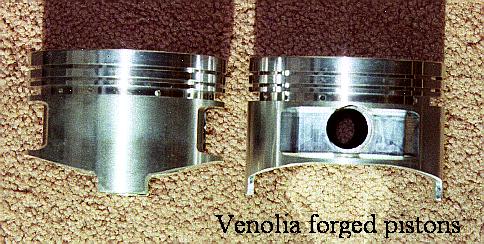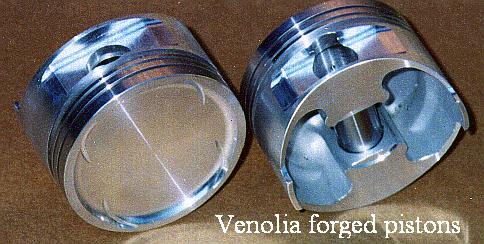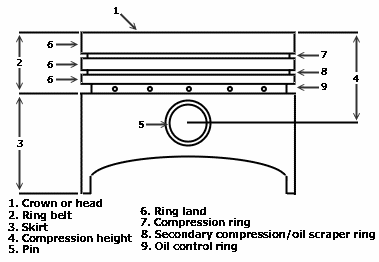Piston Upgrade Guide for the 3000GT/Stealth 6G72 Engine
by Jeff Lucius
Our factory cast aluminum pistons are what Mitsubishi calls "autothermic type with steel struts cast into it". The steel struts provide structural support and help control thermal expansion. The stock pistons are fine for stock engines. However, when engine modifications lead to power output over 400 HP and boost values over 15 psi, forged aluminum pistons should be considered.
Forged pistons are stronger and often a little lighter than cast pistons. Our stock cast piston weighs about 400 grams; a forged piston replacement can weigh between ~350 and 400 grams. The densely-packed molecules in forged pistons allow them to conduct heat away from the piston top quickly so that forged piston crowns can run 75ºF to 100ºF cooler than cast piston crowns (450ºF instead of 550ºF typically). However, forgings often have much less silicon content than cast pistons and expand more when heated than cast pistons do. This requires slightly larger piston-to-cylinder wall clearances (0.005" instead of 0.001", for example) and oil consumption and blow-by may be higher with forged than with cast pistons. The higher clearance can also cause forged pistons to be a bit noisier than cast pistons until they warm up. Forged pistons, with pins and rings, can cost more than cast pistons ($660 to $1200 for forgings instead of $600 or less for a set of six castings; list prices for factory parts: pistons are ~$67 each, the ring set is ~$184 [~$589 total]).
There are two common alloys used in forged pistons, 4032 and 2618. Silicon-aluminum alloys, such as 4032, have great wear characteristics because the silicon particulate hardens the alloy and reduces the thermal coefficient of expansion. However, silicon-aluminum alloys can turn brittle and become prone to fracturing when subjected to extreme stress. With a piston made of a silicon alloy once a crack starts, it doesn't stop until the piston suffers a catastrophic failure. Low- or no-silicon alloys, such as 2618, may wear a bit faster but provide better strength and durability. In the rare case of a crack in a 2618 piston, the crack will migrate to an area of lower stress and stop. 2618-alloy pistons keep their shape under extreme pressures and high RPM's.
Some owners have considered hypereutectic cast pistons as an alternative to forged pistons. Hypereutectic cast pistons could be an upgrade for normally-aspirated engines. However, A.Graham Bell in his recent book "Forced Induction Performance Tuning" (published in 2002 by Haynes) says they are a poor choice for turbocharged engines. Hypereutectic cast pistons have about twice as much silicon in the aluminum alloy as regular cast pistons (15-20% instead of only 7-8%). According to Bell, the added silicon leaves them "quite brittle and, as such, prone to breaking when subjected to detonation."
A question often asked when rebuilding an engine is "How much can I overbore the cylinders?". From the service manual's engine cross sections I guessed that the cylinder wall thickness might be 0.25". Joe Gonsowski (Mitsubishi Engineer) had his block sonic tested (top, middle, and bottom of bore) during his engine rebuild. Average wall thickness was 0.288" with a minimum value of 0.231 inches. Ray Pampena (Mitsubishi Master Tech and race engine builder) measured wall thickness for each cylinder in four places with a sonic tester and found an average wall thicknes of 0.300 inches. Ray notes that blocks sometimes core shift, which might reduce wall thickness to as little as 0.150". Always have a block sonic tested to measure wall thickness before boring the cylinders. An average wall thickness of 0.200" is considered by many as safe for our engines. However, Ray says that wall thickness can be as little as 0.100", but this greatly increases the risk of cracking if severe detonation occurs.
The stock bore is 91.1 mm (3.5866"), and Mistubishi provides factory pistons up to 0.040" over factory bore. I had my engine bored 0.050" over stock, which increases the bore to 92.38 mm for a displacement increase of 84 cc to 3056 cc from the stock 2972.3 cc. This reduced average wall thickness to about 0.238-0.250" (acording to Joe's and Ray's measurements; I do not know if my engine builder sonic tested my block). After twelve thousand miles I have not encountered any problems, but the increase in wall deflection and stress may reduce the durability of the engine somewhat over the long term. Some of our alloy-steel block 6G72 engines have been bored 0.075" over stock resulting in a 93 mm bore, which increases displacement by 126.1 cc to 3098.4 cc and reduces average wall thickness to 0.213-0.225". Ray Pampena bored his block 0.100" over, which increases displacement 5.67% to 3141 cc (see the table below for overboring comparisons) and leaves an average wall thickness of 0.200" for his engine.
The pistons listed below can be purchased from the manufacturers and from many speed shops and parts supply stores. I suggest contacting the speed shops that specialize in our cars listed on my Garage Page. You can also discuss how much to over bore your cylinders with these shops. Some piston manufacturers, like Ross, have worked with 3000GT/Stealth owners to incorporate design improvements.
Note: Because our engine blocks are alloy steel, care must be taken when honing the cylinders. This should be discussed with your engine builder.
- Arias Forged Racing Pistons
13406 S. Normandie Avenue
Gardena, CA 90249
- CP Pistons
1902 MvGaw Ace
Irvine, CA 92614
- JE Pistons
15342 Connector Lane
Huntington Beach, CA 92649
- 714-898-9763
- http://jepistons.com/
- Uses TRW forgings
2618, 4032, and high-silicon 2618 alloys available
- Stock and custom designs
- Ross Racing Pistons
625 S. Douglas
El Segundo, CA 90245
- Venolia Pistons and Rods
2160 E. Cherry Industrial Circle
Long Beach, CA 90805
- 562-531-8463, 323-636-9329
- http://www.venolia.com/
- No-silicon 2618 T-61 alloy
- Stock or custom designs
- I have heard that current prices including rings are about $700 to $800
- Here are the details for the Venolia pistons I have.
New pistons, pins, and pin retainers directly from Venolia for ~$500
Job #: 117853
Alloy: 2618-T61 (no silicon)
Bore Size: 3.637" (0.050" over size)
Suggested Clearance: 0.005"
Ring Type: 1.5mm X 1.5mm X 4mm (0.060" x 0.060" x 0.160")
Pin Diameter: 0.866"
Pin Length: 2.500"
Weight (no pin, retainers, or rings): ~377 grams
- Scott (iceman ii on the 3SI message board) informed me on Dec 5, 2006 that "the pins are machined from bar stock 4340 alloy, internally tapered for strength and weight reduction (they are thicker in the center, and thinner on the ends), and hardchromed on the external surface."
- For information on the 0.050" over-bore pistons I used look at 2-venolia.htm and 2-venolia_wjc.htm
- Available from Venolia for about $500.
- Wiseco Piston, Inc.
7201 Industrial Park Blvd.
Mentor, OH 44060-5396
- 800-321-1364 (orders)
440-951-6600 (tech line)
- http://www.wiseco.com/
- Low-silicon 2618 alloy (for piston kit R18301557)
- Stock and custom designs
- Here are the details for the Wiseco pistons Trevor James bought.
New pistons, rings, and pins from http://www.raceeng.com/ for $660
Kit Part #: R18301557
Alloy: 2618 (low silicon)
Compression Height: 1.261"
Bore Size: 3.6260" (0.039" over size)
Suggested Clearance: 0.0040"
Ring Type: 1.5mm X 1.5mm X 4mm (0.060" x 0.060" x 0.160")
Wrist Pin #: S566
Pin Diameter: 0.866"
Pin Length: 2.500"
Wrist Pin Retainers: W5594
Retainer Width/Wire Diameter: 0.072
Weight (no pin, retainers, or rings): ~347 grams
- Michael Perry informed me on Jan 15, 20003 that Wiseco now mass produces two different size pistons for our cars. The 0.015" over pistons are kit part number K570M915. I am not sure of the details on these pistons and how similar they are to the ones Trevor described above. John Adams mentions in a post on 3si.org that Wiseco also sells 0.035" and 0.055" oversized pistons.
- Avaliable at Import Evolution ($575 for the 0.015" or 0.055" oversized pistons) and Import Performance Parts ($659 for the 0.015", 0.035" or 0.055" overssized pistons).
Pictures and Terminology
The Venolia pistons pictured below are a close copy of the stock pistons as far as valve reliefs in the crown, ring positions, and compression height. If you want to reduce the compression ratio (to compensate for the compression ratio increase from the larger bore) then the compression height can be decreased to lower the piston in the cylinder or the crown possibly could be dished a little deeper to increase the combustion chamber volume.



Over-boring and Compression Ratio
STOCK (turbocharged 6G72):
stock bore: 91.1 mm; 3.587 in.
stock stroke: 76 mm; 2.992 in.
stock displacement: (bore/2)^2 x PI x stroke
= 3.587/2 x 3.587/2 x 3.14159 x 2.992 = 30.235 CI (total=181.41 CI)
= 91.1/2 x 91.1/2 x 3.14159 x 76 => 0.495382 L (total=2.9723 L)
stock CR = 8.0:1
The total volume (TV) equals the swept volume (SV, or displacement) plus combustion chamber volume (CV) which together are the 8 parts (in the 8 to 1 ratio). At TDC, the CV represents the 1 part (in the 8 to 1 ratio). Therefore, the SV equals 7 parts.
TV = SV + CV
At BDC, volume = TV = 8 x CV
At TDC, volume = CV
Stock CR = (8 x CV) : CV = (SV + CV) : (CV) = (7 + 1) : 1 = 8 : 1
So, CV = one seventh of the SV (or displacement).
Stock CV = 30.237 / 7 = 4.319 CI (or 0.070769 L)
BORE CHANGE ONLY (no change to piston crown, compression height, or stroke):
I'll use my car as an example. New bore = 92.38 mm; 3.637 in.(0.050 in. over stock)
New displacement (or SV)
= 31.084 CI (total = 186.5 CI)
= 0.50940 L (total = 3.0564 L)
New CR
= (SV + CV) / CV
= (31.084 + 4.319) / 4.319 = 8.197:1
= 8.2:1 (close enough)
The displacement with 0.050" overbore represents a 2.8% increase over the stock displacement.
| 6G72 Block Overboring Comparison |
| Overbore |
Bore (mm) |
Bore (in) |
Total CI |
Total cc |
% Larger |
CR |
Wall thickness |
| 0.000" |
91.11 |
3.587 |
181.41 |
2972.3 |
0.00 |
8.00 |
0.288-0.300" |
| 0.010" |
91.36 |
3.597 |
182.42 |
2989.4 |
0.58 |
8.04 |
0.278-0.290" |
| 0.020" |
91.62 |
3.607 |
183.44 |
3006.0 |
1.14 |
8.08 |
0.268-0.280" |
| 0.030" |
91.87 |
3.617 |
184.46 |
3022.7 |
1.70 |
8.12 |
0.258-0.270 |
| 0.040" |
92.13 |
3.627 |
185.48 |
3039.5 |
2.26 |
8.16 |
0.248-0.260" |
| 0.050" |
92.38 |
3.637 |
186.50 |
3056.3 |
2.82 |
8.20 |
0.238-0.250" |
| 0.060" |
92.63 |
3.647 |
187.53 |
3073.1 |
3.39 |
8.24 |
0.228-0.240" |
| 0.070" |
92.89 |
3.657 |
188.56 |
3090.0 |
3.96 |
8.28 |
0.218-0.230" |
| 0.075" |
93.01 |
3.662 |
189.08 |
3098.4 |
4.24 |
8.30 |
0.213-0.225" |
| 0.080" |
93.14 |
3.667 |
189.59 |
3106.9 |
4.53 |
8.32 |
0.208-0.220" |
| 0.090" |
93.40 |
3.677 |
190.63 |
3123.9 |
5.10 |
8.36 |
0.198-0.210" |
| 0.100" |
93.65 |
3.687 |
191.67 |
3140.9 |
5.67 |
8.40 |
0.188-0.200" |
MILL ONLY:
The combustion chamber opening is circular at the top of the block so milling will only remove a small cylinder from the CV. Let's assume we mill at the service limit of 0.2 mm (0.008 in).
Removed volume = (bore/2)^2 x PI x thickness
= 3.587/2 x 3.587/2 x 3.14159 x 0.008 = 0.0808 CI.
New CV = 4.319 - 0.0808 = 4.2372
New CR
= (SV + CV) / CV
= (30.235 + 4.2372) / 4.2372 = 8.1356
= 8.14:1 (close enough)
MILL (0.008") and BORE (0.050 in. over)
Removed volume
= 3.637/2 x 3.637/2 x 3.14159 x 0.008 = 0.0831 CI.
New CV = 4.319 - 0.0831 = 4.2359
New CR
= (31.084 + 4.2359) / 4.2359) = 8.3382
= 8.34:1 (close enough)
Acknowledgments
Some of the information presented here was gathered from various email lists, message boards, and vendor web sites. I would like to particularly thank Ray Pampena, Jeff Crabtree, John Adams, Trevor James, and Joe Gonsowski for their contributions.
Page last updated December 25, 2006.





